| Common name | Scientific name and subspecies | Range | Size and ecology | IUCN status and estimated population |
|---|
Rosy-faced lovebird
or peach-faced lovebird  | Agapornis roseicollis
(Vieillot, 1818)
- Agapornis roseicollis catumbella, B.P. Hall, 1952
- Agapornis roseicollis roseicollis, (Vieillot 1818)
| Southwest Africa
 | Size: 17–18 cm (6.5–7 in) long. Green and pink. Has blue rump feathers.
Habitat: South Africa, Angola, Namibia
Diet: herbivores, granivores | LC
|
|---|
| Yellow-collared lovebird or masked lovebird  | Agapornis personatus
Reichenow, 1887 | Northeast Tanzania
 | Size: 14 cm (5.5 in) long. Yellow and green. Has blue tail feathers.
Habitat: Tanzania
Diet: herbivores, granivores | LC
|
|---|
| Fischer's lovebird 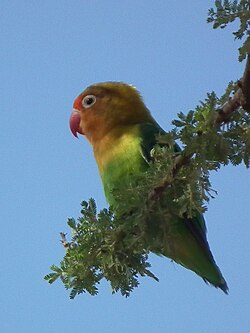 | Agapornis fischeri
Reichenow, 1887 | South and southeast of Lake Victoria in northern Tanzania
 | Size: 14 cm (5.5 in) long. Mostly green, orange upper body and head, blue lower back and rump, red beak, white eyerings.
Habitat: Tanzania
Diet: herbivores, granivores, frugivores | NT
|
|---|
Lilian's lovebird
or Nyasa lovebird  | Agapornis lilianae
(Shelley, 1894) | Malawi
 | Size: 13 cm (5 in) long. Mostly green including green back and green rump, orange head, red beak, white eyerings.
Habitat: Malawi, Mozambique, Tanzania, Zambia, Zimbabwe
Diet: herbivores, granivores, frugivores | NT
|
|---|
| Black-cheeked lovebird 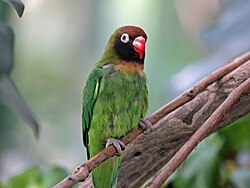 | Agapornis nigrigenis
W.L. Sclater, 1906 | Zambia
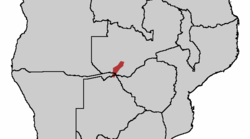 | Size: 14 cm (5.5 in) long. Mostly green, brownish-black cheeks and throat, reddish-brown forehead and forecrown, orange upper chest, red beak, white eyerings.
Habitat: Zambia
Diet: herbivores, granivores | VU
|
|---|
Grey-headed lovebird
or Madagascar lovebird 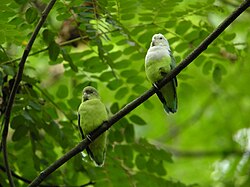 | Agapornis canus
(Gmelin, 1788)
- Agapornis canus ablectaneus, Bangs, 1918
- Agapornis canus canus, (Gmelin, 1788)
| Madagascar | Size: 13 cm (5 in) long. Mostly green with darker green on back, pale grey beak. Sexual dimorphism: male has a grey upper body, neck and head.
Habitat: Madagascar
Diet: | LC
|
|---|
Black-winged lovebird
or Abyssinian lovebird 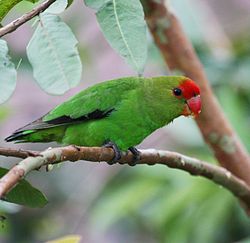 | Agapornis taranta
(Stanley, 1814) | Southern Eritrea to southwestern Ethiopia | Size: 16.5 cm (6.5 in) long. Mostly green, red beak, some black wing feathers. Sexual dimorphism: only the male has red on forehead and crown, female's plumage is all green.
Habitat: Eritrea, Ethiopia
Diet: herbivores, granivores, frugivores | LC
|
|---|
Red-headed lovebird
or red-faced lovebird  | Agapornis pullarius
(Linnaeus, 1758)
- Agapornis pullarius pullarius, (Linnaeus, 1758)
- Agapornis pullarius ugandae, Neumann, 1908
| Large part of central Africa | Size: 15 cm (6 in) long. Mostly green with red on upper neck and face. Sexual dimorphism: the male has more extensive and a darker red on face and head, and the male has a darker red beak than the female.
Habitat: Equatorial Guinea, Angola, Benin, Burundi, Cameroon, Central African Republic, Chad, Congo, DR Congo, Cote d'Ivoire, Ethiopia, Gabon, Ghana, Guinea, Kenya, Mali, Niger, Nigeria, Rwanda, Sierra Leone, South Sudan, Sudan, Tanzania, Togo, Uganda
Diet: | LC
|
|---|
Black-collared lovebird
or Swindern's lovebird  | Agapornis swindernianus
(Kuhl, 1820)
- Agapornis swindernianus emini, Neumann, 1908
- Agapornis swindernianus swindernianus, (Kuhl, 1820)
- Agapornis swindernianus zenkeri, Reichenow, 1895
| Equatorial Africa
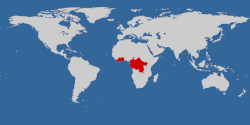 | Size: 13.5 cm (5 in) long. Mostly green, brown collar which has a black upper margin at the back of the neck, dark grey/black beak.
Habitat: Equatorial Guinea, Cameroon, Central African Republic, Congo, DR Congo, Cote d'Ivoire, Gabon, Ghana, Liberia, Uganda
Diet: herbivores, frugivores | LC
|
|---|
| Long-legged lovebird  | Agapornis longipes
Pavia, 2024 | Cradle of Humankind | Size:
Habitat:
Diet: | EX
|
|---|




















